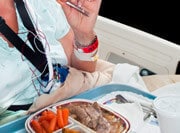Part One – Food Allergies

Patient safety in healthcare should be priority #1. Did you know that one in four Medicare patients will experience an accident or error that could be life threatening while in a hospital? Most people think of medication or procedural errors causing a patient harm. Have you ever thought that the Foodservice Department can cause accident, errors, and even the death of a patient?
What about food allergies? It is estimated that 11 million Americans suffer from food allergies. There is no cure for food allergies; avoidance is the only way to prevent a reaction.
Food allergy reactions will move quickly through the body causing symptoms such as swelling of the lips, mouth, tongue, hives, difficulty breathing, abdominal cramping, vomiting and diarrhea. Anaphylaxis, a life-threatening allergic reaction can cause symptoms such as rapid drop in blood pressure and cardiovascular events.
Patients with food allergies rely on the foodservice staff to provide them with accurate information about ingredients used to prepare meals so; the patient can make informed decisions on what to eat. Good communication, teamwork and cooperation from the entire medical staff are crucial to ensure that patients are safe from food allergies during their stay.
The most common food allergies are items that are found on hospital menus and in most common recipes. Minute or trace amounts of these foods can cause an allergic react in sensitive patients.
- Milk
- Eggs
- Peanuts
- Tree nuts
- Fish
- Shell fish
- Soy
- Wheat
The process in which food allergy information is communicated to the appropriate staff is crucial to eliminating errors and keeping patients safe. In these days where computer automation is prevalent in every life it’s hard to believe that there are foodservice departments in healthcare facilities that do not have access to a specialized food automation system. It is imperative for the foodservice department to have a fully integrated food and nutrition soft system that can receive patient information from the hospitals HIS system to prevent a patient from receiving foods that they are allergic to.
When the patient is admitted, they either talk to the admission clerk, nurse or even the physician conducting their history and physical, whoever the patient comes in contact with first should be asking if there are any food allergies. That information is entered into the HIS system, filtered than sent automatically to the foodservice automation system. At this time, the Dietitian should also be alerted to consult this patient on their allergies as well. With a food and nutrition automation system the risk of serving this patient a food item that can cause an allergic reaction can be eliminated with an expectation of 100% accuracy. It’s important that a food and nutrition system is selected with an enhanced menu management system. This will ensure that the daily menus ONLY display the food items allowed for that patient to select. Menu selections are printed according to menu day and individual dietary restrictions with considerations for the specific requirements to accommodate patient allergies, eliminating and reducing errors often found in manual process.
Excellent foodservice staff education and monitoring to ensure all HACCP protocols are followed eliminating the event of cross contamination with a food item that may cause a patient an allergic reaction. A prime example where cross – contamination occurs is the deep fryer. French fries fried in the same oil as fish could cause an allergic reaction which could be life threating to a patient with a fish allergy. Having separate fryers for fish only is an important consideration if not the law in your state!
A foodservice automation system and continuous education for the staff is are key components to ensure that patient meal ordering, food handling, and preparation procedures are followed to eliminate food allergy that can put the patient’s safety at risk and promote your health systems initiative to make patient safety first.
For more information on caring for patients with food allergies in healthcare visit – www.foodallergy.org
For more information on healthcare food service software and patient food allergies and safety visit – www.vstech.com
References/article citation:
Healthcare IT News, retrieval date 7/16/2012
www.healthcareitnews.com/
Food Allergy Training Guide for Hospital and Food Service Staff, retrieval date 7/18/2012
www.foodallergy.org






